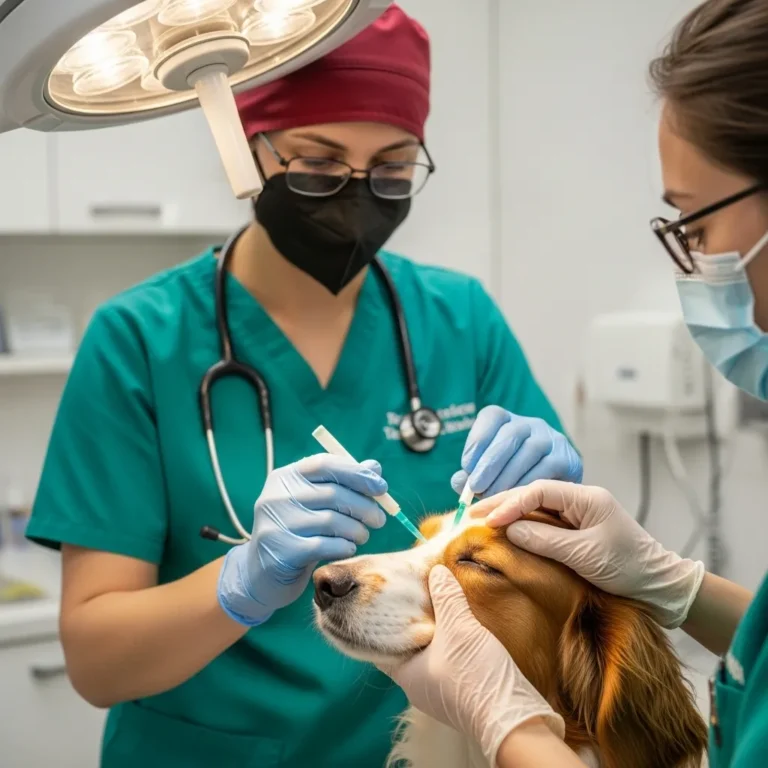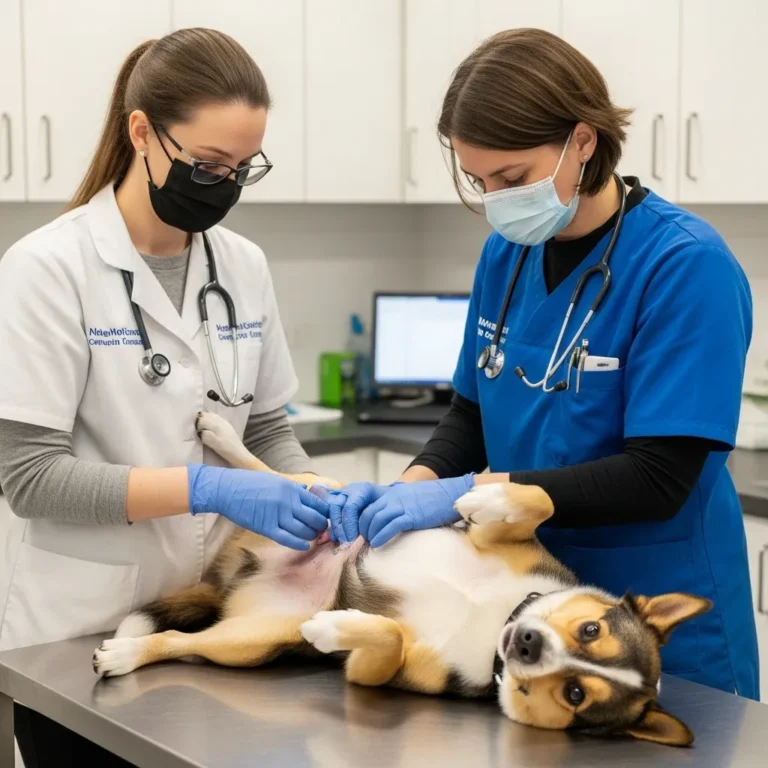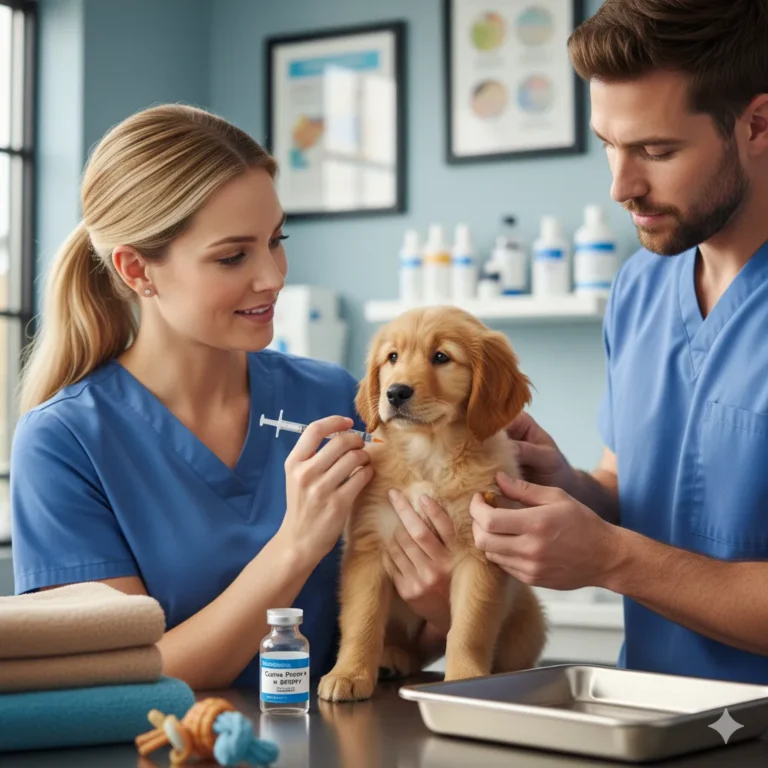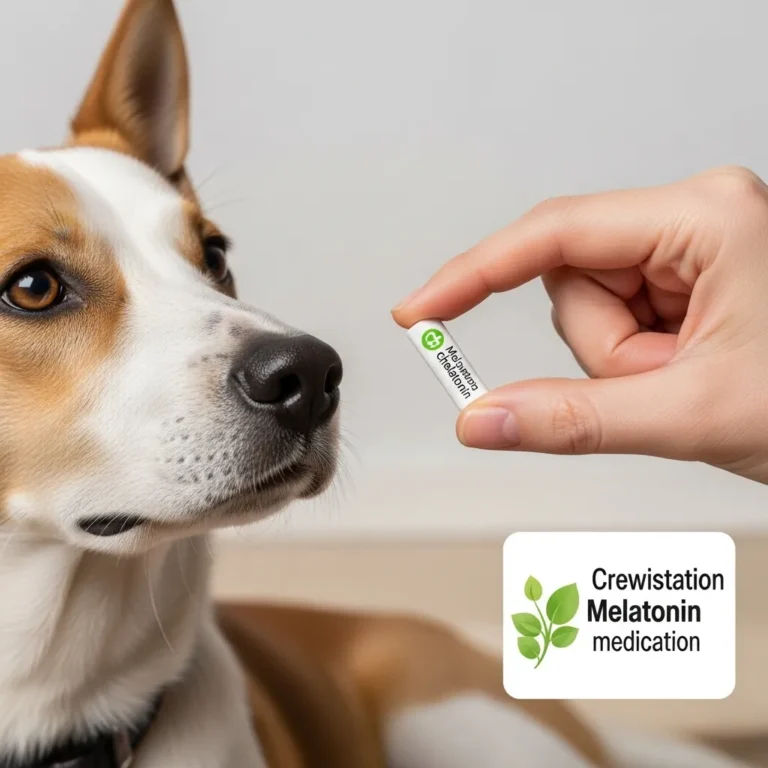
Author: DogsBlogSS Team
⚠️ Disclaimer: This article is for informational purposes only and is not a substitute for consulting a veterinarian.
Eye Ulcer in Dogs
Our furry friends rely on their eyes to explore the world — from chasing butterflies in the garden to gazing lovingly as you call them for dinner. So, when a dog develops an eye ulcer, it’s something no pet parent wants to ignore. An eye ulcer, or corneal ulcer, can be painful, worrisome, and in some cases serious. But the good news? With prompt veterinary care, many dogs recover fully. In this article, I’ll walk you through what an eye ulcer is, how to spot it, how veterinarians treat it, and how you can help your dog heal — all in a way that feels like a chat between friends, not a medical lecture.
Understanding Eye Ulcers
What is an eye ulcer in dogs?
According to petmd: An eye ulcer in a dog — more precisely called a corneal ulcer or ulcerative keratitis — is when part of the cornea (the clear, front surface of the eye) erodes or develops a “dent.”
According to PetMD: It might only affect the very top layer, or it can dig deeper into the cornea, depending on how bad it is.
How do dogs get eye ulcers?
According to PetMD: There are lots of ways a dog might develop an eye ulcer. Sometimes it’s sheer bad luck — a stick whips into their eye during a game, or a stray blade of grass gets stuck. Trauma like scratches, foreign bodies, and chemical irritation (say, shampoo splashes) are common culprits.
According to PetMD: But there are more subtle causes too: infections (bacterial, viral, fungal), poor tear production (a condition called keratoconjunctivitis sicca, or “dry eye”), or even an eyelid disorder like entropion (where the eyelid rolls inward) can create a problem.
According to PetMD: Some endocrine diseases like diabetes or Cushing’s, or inherited eye conditions, may also predispose a dog to ulcers.
What are the different types of eye ulcers in dogs?
Not all corneal ulcers are the same. Here are some of the main types:
- According to PetMD: Superficial ulcers: Only the very top layer of the cornea is affected. These are often simpler and heal more quickly.
- According to vetspecialists: Persistent (indolent) ulcers, also known as SCCED (Spontaneous Chronic Corneal Epithelial Defect): These are shallow but stubborn, and the edge of the ulcer may not heal properly.
- According to PetMD: Stromal ulcers: These penetrate deeper into the cornea’s stroma, and may become infected or even “melt” (a bad but real term, meaning rapid tissue breakdown).
- According to rvc.ac: Melting ulcers: Very serious — the cornea degrades quickly due to enzymes often associated with infection.
- According to petmd: Ulcers with foreign bodies: Sometimes a piece of debris lodges in the cornea; that complicates healing and may require surgical removal.
Are some dog breeds more prone to eye ulcers?
According to pdsa: Yes — certain breeds face higher risks. Brachycephalic (flat-faced) breeds, like Pugs, Bulldogs, or Shih Tzus, are more likely to get ulcers. Their protruding eyes and facial structure make the cornea more exposed and vulnerable.
According to PetMD: Also, breeds with tear production issues or inherited corneal problems may be more prone. For example, Boxers, Cavalier King Charles Spaniels, Beagles, and Cocker Spaniels can sometimes develop recurrent non-healing ulcers.
Recognizing the Symptoms
What are the common signs of an eye ulcer in a dog?
When a dog has an ulcer, a loving observer might pick up:
- According to PetMD: Excessive blinking or squinting
- According to pdsa: Red, bloodshot eyes
- According to PetMD: Tearing or discharge — sometimes yellow/green in more severe cases
- According to petsvetcheck: Swelling around the eyelid or eye corner
- According to PetMD: Pawing at the eye or rubbing their face on surfaces
- According to PetMD: A raised third eyelid (the little extra eyelid in the inside corner)
- According to pdsa: Holding the eye closed or avoiding light.
How can I tell if my dog has an eye ulcer?
YAccording to PetMD: ou know your dog best. But if you notice any of the above symptoms — especially squinting, redness, or an unusual discharge — it’s worth calling the vet. A veterinarian will likely do an eye exam, possibly using a fluorescein stain (a dye that highlights areas where the cornea is damaged) to see if there’s an ulcer.
According to vetster: Sometimes, though, the ulcer isn’t obvious just by looking; that’s why that dye test is so useful.
Do eye ulcers always cause pain in dogs?
According to animaltrust: Often, yes — but not always. Many dogs with ulcers blink a lot, avoid opening that eye, or paw at it. But milder ulcers, especially superficial ones, might not be dramatically painful, so the signs can be subtle.
What does a dog’s eye look like with an ulcer?
According to petsvetcheck: A dog’s eye with an ulcer can look cloudy or slightly milky, especially if the ulcer is deeper.
According to PetMD: There may also be redness, swelling, and discharge. In a more advanced ulcer, the crater or “dent” might be seen when the vet uses fluorescein dye.
Diagnosis and Veterinary Care
How does a vet diagnose an eye ulcer in a dog?
According to PetMD: When you bring your dog in with suspected eye problems, the vet will start with a thorough eye exam: looking for foreign bodies, checking eyelid anatomy, and assessing how well the eye is closing and blinking.
According to PetMD: Then, they’ll probably use a fluorescein stain test — they place a drop of dye in the eye, and any ulcerated area will pick up the color, making it visible under blue light.
What tests are performed to confirm an eye ulcer?
Beyond the stain, a vet may run:
- According to PetMD: Schirmer tear test to check tear production (important, because dry eye can cause ulcers).
- According to PetMD: Intraocular pressure (tonometry) to measure pressure inside the eye (but in very deep ulcers, vets may skip this to avoid rupture).
- According to PetMD: Bacterial culture from the cornea, if infection is suspected.
- According to PetMD: Cytology, which is taking a small sample of cells to look under a microscope, especially for chronic or complicated ulcers.
Is it an emergency if my dog has an eye ulcer?
According to PetMD: It can be. While some superficial ulcers might heal on their own with proper care, others — especially deep, melting, or complicated ones — are true emergencies.Leaving an ulcer untreated can lead to infection, worsening damage, or even perforation (a hole forming in the eye).
What should I do if I suspect my dog has an eye ulcer?
If you think your dog has an ulcer:
- Call your vet right away.
- According to PetMD: Try to prevent your dog from rubbing or pawing the eye — an Elizabethan collar (cone) can help.
- Don’t wait: early diagnosis and treatment improve outcomes significantly.
Treatment Options
What are the treatment options for eye ulcers in dogs?
According to PetMD: Treatment depends a lot on the type and severity of the ulcer: superficial ulcers often heal with medication, while more complex ones may need surgery. PetMD
Are there different medications for different types of ulcers?
According to PetMD: Yes. For mild, uncomplicated ulcers, vets usually prescribe broad-spectrum topical antibiotics, often several times a day, and sometimes topical pain medication.
If the ulcer is more complicated, treatment may include:
- According to PetMD: Potent antibiotic drops (or ointments) every few hours.
- According to PetMD: Oral pain meds and systemic antibiotics.
- According to pdsa: Lubricating “tear” drops to keep the eye moist.
- According to pdsa: Atropine eye drops to help with pain and pupil dilation in some cases.
According to PetMD: Sometimes, bandage contact lenses are used to protect the cornea as it heals.
When is surgery necessary for a dog’s eye ulcer?
Surgery becomes a strong consideration when:
- According to PetMD: The ulcer is deep, “melting,” or infected. PetMD
- According to vetspecialists:It’s a non-healing (indolent) ulcer like SCCED.
- According to PetMD: There’s a foreign body embedded in the cornea that can’t be removed safely without surgery.
What is a “grid keratotomy” and when is it used?
According to dvm360: A grid keratotomy is a delicate but powerful surgical technique. Using a tiny needle (22–25 gauge), a vet makes superficial scratches or striations in the cornea in a grid pattern.
According to vetspecialists: This helps stimulate healing by encouraging the healthy epithelial cells to anchor and close the ulcer.
According to dvm360: It’s generally used for non-infected, superficial, non-healing ulcers. Afterward, medical therapy continues, and the dog usually wears a cone and receives pain relief.
How long does it take for an eye ulcer to heal?
- According to PetMD: Simple, superficial ulcers often heal within 7–10 days with treatment.
- IAccording to vetspecialists: ndolent (SCCED) ulcers may take several weeks (even months) to heal, especially if treatments like debridement, grid keratotomy, or diamond burr debridement are needed.
- According to PetMD: Deep or complicated ulcers could require more intense therapy and follow-up, sometimes with surgical grafts, and healing may take considerably longer.
What is the prognosis for dogs with eye ulcers?
According to PetMD: With timely and appropriate care, many dogs do very well. For simple ulcers, the prognosis is excellent.
According to vetster: For deeper or complicated ulcers (melting, chronic, or those requiring surgery), the prognosis is more guarded, but with a skilled veterinary ophthalmologist, many dogs still recover good vision.
Managing Recovery and Prevention
How can I care for my dog at home after an eye ulcer diagnosis?
Once your vet has diagnosed an ulcer and started treatment:
- According to PetMD: Put on the Elizabethan collar (cone) and ensure it stays on during recovery.
- Administer all prescribed eye drops or ointment exactly as directed.
- According to PetMD: Maintain follow-up vet appointments to monitor healing, often using repeat fluorescein staining.
- Try to keep your dog calm and prevent any pawing, rubbing, or trauma to the eye.
- Give any systemic pain meds your vet prescribed to help keep them comfortable.
What are the potential complications of eye ulcers?
If left untreated or poorly managed, eye ulcers can:
- According to rvc.ac.: Become infected, possibly leading to “melting” or rapid tissue breakdown.
- According to pdsa: Perforate (a hole may form), risking loss of the eyeball.
- Scar, which could affect vision.
- According to vetspecialists: Recur, especially in dogs with underlying issues like SCCED.
How can I prevent my dog from getting eye ulcers?
Some heartfelt, simple steps can really help:
- According to pdsa: Be cautious during play — avoid thorny bushes, rough vegetation, and objects that could injure the eye.
- According to vetster: Keep long hair around the dog’s face trimmed, especially near the eyes.
- According to todaysveterinarynurse: Regularly check for signs of dry eye, especially in breeds known for tear issues, and have your vet perform a Schirmer tear test if needed.
- According to isvma: If your dog has eyelid issues (entropion, distichiasis, etc.), discuss surgical correction with your vet to prevent chronic irritation.
- According to animaltrust: Avoid letting your dog rub their head out of car windows — that’s a surprisingly common cause of injury.
Are there any home remedies for dog eye ulcers?
It’s tempting to try home remedies — after all, we just want our pup to feel better. But when it comes to eye ulcer dog, self-treatment is risky. These are delicate wounds on a sensitive structure. Using unprescribed drops, herbal remedies, or over-the-counter human eye products can make things worse. Instead:
- Use the medications exactly as your vet prescribes.
- Avoid applying anything “just because you read about it online.”
- If things don’t improve, call your vet rather than trying anything new without professional guidance.
What should I expect during my dog’s recovery from an eye ulcer?
According to PetMD: Healing is often gradual. For mild ulcers, you may see improvement in a week, but your vet will likely want to re-stain the cornea to confirm healing.
For more stubborn or deep ulcers, the process may be longer: repeat treatments, rechecks, even adjustments in therapy can happen. Throughout, the vet will check for signs of worsening (infection, melting) or for complications (scarring, vascularization). Over time, with good care, many dogs return to normal, but patience and consistent follow-up are key.
Related Concerns
Can eye ulcers lead to blindness in dogs?
According to pdsa: In severe or untreated cases, yes. Deep ulcers, melting ulcers, or those that perforate can threaten the structure of the eye and risk vision loss.Prompt veterinary treatment minimizes this risk.
Are eye ulcers contagious to other dogs or humans?
According to vetster: No — corneal ulcers in dogs are not contagious, either to other dogs or to people.The ulcer is a wound, not an infection that spreads like a cold.
What’s the difference between an eye ulcer and conjunctivitis?
According to PetMD: Good question. Conjunctivitis (often called “pink eye”) is inflammation of the conjunctiva (the mucous membrane lining the eyelid and part of the eye). It may cause redness, discharge, and irritation — but no erosion of the cornea. An ulcer, by contrast, involves a defect or “dent” in the cornea itself. The diagnosis is different, and so is the treatment. A vet usually uses a fluorescein stain to confirm an ulcer, which wouldn’t light up in simple conjunctivitis.
Conclusion
Seeing your dog squint, blink excessively, or paw at their eye is a heart-wrenching experience. But much of the worry can be eased if you act quickly, get veterinary care, and follow the prescribed treatment. Corneal ulcers in dogs might be common, but with the right support, many heal beautifully without lasting damage.
Think of recovery as a team effort — you, your vet, and your pup all working together. You provide the love (and the cone), your vet provides the expertise, and your dog brings the bravery (even if they don’t act like it). Keep an eye (excuse the pun) on them during healing, stick to follow-up visits, and don’t hesitate to ask questions. After all, no one knows your dog better than you do.
Notice : The DogsBlogSS editorial team is dedicated to providing accurate, research-based information about dog health, behavior, and care. All our articles are fact-checked using trusted veterinary sources such as VCA Hospitals, Merck Vet Manual, and the AKC.
you may like it








